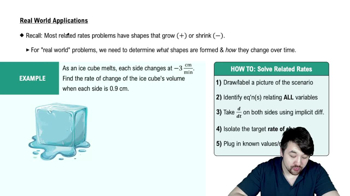Table of contents
- 0. Functions7h 52m
- Introduction to Functions16m
- Piecewise Functions10m
- Properties of Functions9m
- Common Functions1h 8m
- Transformations5m
- Combining Functions27m
- Exponent rules32m
- Exponential Functions28m
- Logarithmic Functions24m
- Properties of Logarithms34m
- Exponential & Logarithmic Equations35m
- Introduction to Trigonometric Functions38m
- Graphs of Trigonometric Functions44m
- Trigonometric Identities47m
- Inverse Trigonometric Functions48m
- 1. Limits and Continuity2h 2m
- 2. Intro to Derivatives1h 33m
- 3. Techniques of Differentiation3h 18m
- 4. Applications of Derivatives2h 38m
- 5. Graphical Applications of Derivatives6h 2m
- 6. Derivatives of Inverse, Exponential, & Logarithmic Functions2h 37m
- 7. Antiderivatives & Indefinite Integrals1h 26m
- 8. Definite Integrals4h 44m
- 9. Graphical Applications of Integrals2h 27m
- 10. Physics Applications of Integrals 2h 22m
4. Applications of Derivatives
Related Rates
Problem 3.11.17
Textbook Question
A circle has an initial radius of 50 ft when the radius begins decreasing at a rate of 2 ft/min. What is the rate of change of the area at the instant the radius is 10 ft?
 Verified step by step guidance
Verified step by step guidance1
First, recall the formula for the area of a circle: A = πr², where A is the area and r is the radius.
To find the rate of change of the area with respect to time, we need to differentiate the area formula with respect to time. This involves using the chain rule since the radius is changing with time.
Apply the chain rule: dA/dt = dA/dr * dr/dt. Here, dA/dr is the derivative of the area with respect to the radius, and dr/dt is the rate at which the radius is changing.
Calculate dA/dr: Differentiate A = πr² with respect to r to get dA/dr = 2πr.
Substitute the values: Use r = 10 ft and dr/dt = -2 ft/min (since the radius is decreasing) into the equation dA/dt = 2πr * dr/dt to find the rate of change of the area at the instant the radius is 10 ft.
 Verified video answer for a similar problem:
Verified video answer for a similar problem:This video solution was recommended by our tutors as helpful for the problem above
Video duration:
6mPlay a video:
Was this helpful?
Key Concepts
Here are the essential concepts you must grasp in order to answer the question correctly.
Related Rates
Related rates involve finding the rate at which one quantity changes in relation to another. In this problem, we need to determine how the area of the circle changes as the radius decreases. This requires applying the chain rule from calculus to relate the rates of change of the radius and the area.
Recommended video:

Intro To Related Rates
Area of a Circle
The area of a circle is calculated using the formula A = πr², where A is the area and r is the radius. Understanding this formula is crucial because we need to differentiate it with respect to time to find how the area changes as the radius changes over time.
Recommended video:

Estimating the Area Under a Curve with Right Endpoints & Midpoint
Differentiation
Differentiation is a fundamental concept in calculus that involves finding the derivative of a function. In this context, we will differentiate the area formula with respect to time to find the rate of change of the area as the radius changes, applying the chain rule to connect the rates of change.
Recommended video:

Finding Differentials
Related Videos
Related Practice





